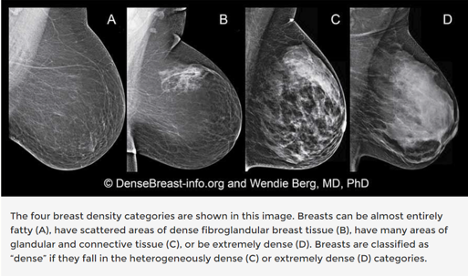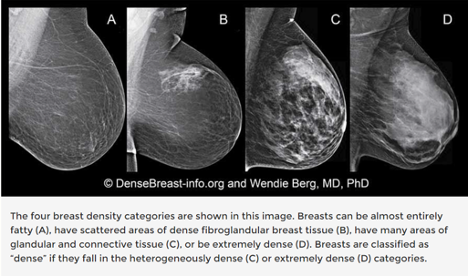The Dense Breast Dilemma
By Carol Miele


Image Credit: Dense Breasts: Answers to Commonly Asked Questions (originally published by the National Cancer Institute.)
“It is like looking for a snowball in a snowstorm.”
That is how my oncologist described looking for a tumor among dense breast tissue (DBT) to me. I’d spent nearly 25 years getting mammograms, but the cancer – which was diagnosed at stage four – may have been undetectable because of my dense breast tissue.
Dense breast tissue is typically less fatty. This is important to know because it may be easier to see a breast tumor in fattier tissue on a mammogram, but dense breast tissue can make it harder for radiologists to see cancer. It was explained to me that that’s because dense tissue appears as whitish clouds on a mammogram film, but so does a tumor – making it difficult to see. It was a shock to learn that a tumor may have been growing undetected in my breast for years.
I learned all of this when I was diagnosed with metastatic breast cancer de novo. A de novo diagnosis means that you are Stage 4 breast cancer from the start. My cancer had metastasized and required treatment for advanced breast cancer from day one, which was incredibly difficult to hear. With this diagnosis, I learned that I would be in treatment for the remainder of my life. As a retired nurse, I couldn’t believe that I was totally unaware of the tumor growing for so long in my body or that it had spread to my bones.
Initially, I challenged the diagnosis because I’d had previous injuries or ‘wear and tear’ in most of the places identified as having bone metastases. I’d had a torn rotator cuff, had chronic bursitis, experienced two auto accidents with injury to my spine, among other injuries that I thought were plausible reasons for inflammation, pain and bony changes in a few. My oncologist ordered MRIs of my spine and pelvis, which showed that the lesions in my bone could only be attributed to cancer. My days of ‘bargaining’ were over and I had to accept my fate.
Almost half of females aged 40+ who get mammograms have DBT. It used to be common for the radiologist to be the only one who monitored for breast density and would send the report to the primary physician without having a conversation about the results. Then came Dr. Nancy Cappello, PhD, who also had DBT. She started the Are You Dense? organization after she was diagnosed with Stage 3 breast cancer in 2004. In her home state of Connecticut, she and her husband worked to get the first Dense Breast Act signed, which requires the radiologist to inform you of your breast density and to determine whether a follow-up ultrasound or breast MRI is required. She then went state-to-state meeting with lawmakers to try to enact this legislation nationwide.
Following the loss of Dr. Cappello – who was able to successfully achieve legislation in 36 states before passing away – the FDA approved the State Mandatory Breast Density Notification to ensure that mammography reports and summaries received by patients and their providers include appropriate information about breast density.
Breast density can only be determined by mammogram. You cannot tell by external appearances or external examination. As a result, follow up testing may be necessary once it's been determined that you have DBT. It is important to talk to your healthcare provider about any questions you have around dense breast tissue in order to be proactive for yourself and/or your loved ones.










